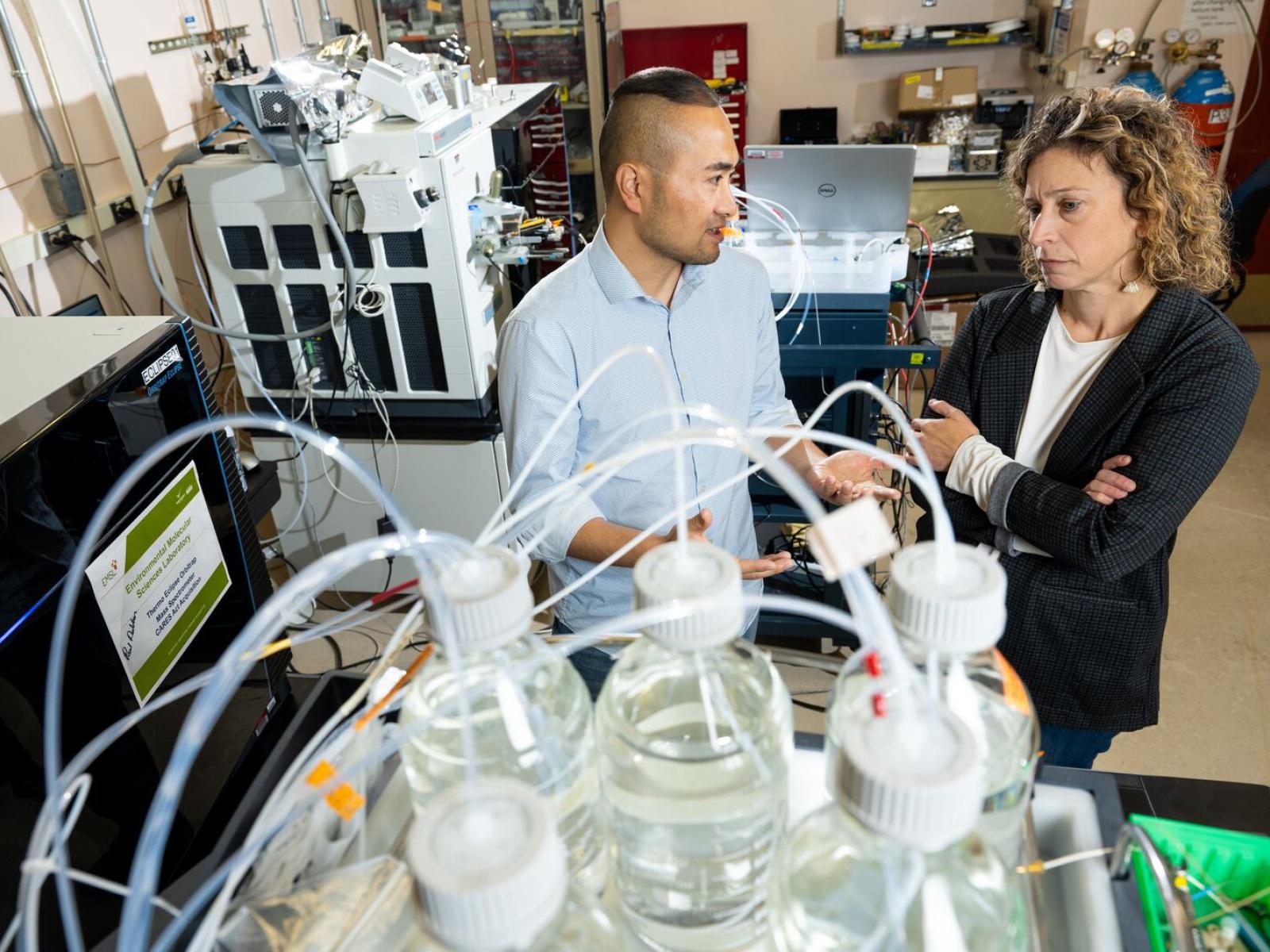Fundamental Science at PNNL Benefits Rare Disease Research
A recent recipient of two CDMRP awards, Sara Gosline, a data and computational scientist at PNNL, studies a rare disease called neurofibromatosis.

Computational biologist Sara Gosline applies mathematical algorithms to develop and test biological hypotheses from vast amounts of omics data in support of health and disease research. Here she learns about the instrumentation from Tao Liu, a PNNL biomedical researcher.
(Photo by Andrea Starr | Pacific Northwest National Laboratory)
A rare disease, as defined by the Orphan Drug Act of 1983, is one that affects less than 200,000 people in the United States. There are over 7,000 rare diseases currently affecting about 30 million people.
Research on rare diseases can be both time consuming and costly, with Congressionally Directed Medical Research Programs (CDMRP) being an important source of funding sponsoring research endeavors in this area of study. Researchers can study both rare and common diseases identified by the Congressional Special Interest Medical Research Programs (CSI). Many rare conditions can be life-threatening, and most do not have treatments. The CDMRP has managed over $7.7 billion in Congressional appropriations for peer-reviewed research aimed to prevent, control, and cure disease.
A recent recipient of two CDMRP awards, Sara Gosline, a data and computational scientist at Pacific Northwest National Laboratory (PNNL), studies a rare disease called neurofibromatosis (NF). The goal of the Neurofibromatosis Research Program (NFRP) is to reduce the clinical impact of the disease. The NFRP supports the research of neurofibromatosis type 1—a rare disease that afflicts 1 in 3000 and causes a myriad of symptoms including benign tumor growth, autism, and malignant peripheral nerve sheath tumors (MPNSTs). These tumors are very deadly with minimal treatment options.
At PNNL, Gosline works to develop computational algorithms that are uniquely targeted for rare disease work by doing foundational research in model system development. This work can be expanded to all model systems in human disease and overall bio preparedness. Beginning in September 2022, Gosline collaborated with Angela Hirbe of Washington University in St. Louis (WUSTL) to explore aneuploidy, or the presence of an abnormal number of chromosomes in patient cells with tumors, under Hirbe’s Investigator Initiated Research Award from CDMRP. Together with Paul Piehowksi from the Environmental Molecular Sciences Laboratory (EMSL) at PNNL, they will attempt to capture spatially resolved proteomics to determine how proteins are changing upon amplification of a common chromosomal aberration in MPNST that has poor prognosis.
Beginning in September 2023, Gosline will work with a team from WUSTL, Johns Hopkins University, and the University of Minnesota (UMN) to build a platform for drug testing MPNST at high throughput. Through the CDMRP Synergistic Idea Award mechanisms, they will characterize tumors from patient samples, patient-derived xenografts, and microtissues to determine which molecular characteristics can predict patient response to various drugs. Gosline’s work at PNNL will be to develop computational techniques to improve drug response prediction.
This work also complements other NF work through a foundation-supported research grant from the Neurofibromatosis Therapeutic Acceleration Program (NTAP), where Gosline will work to profile the benign tumors that arise in NF1 patients and identify putative drugs via patient-derived organoid models. “The computational challenges we have in rare disease research require technological advances that can translate across many domains here at PNNL. It’s exciting to be able to address these challenges directly to help identify new treatments for NF1 and also strengthen the lab’s scientific capabilities”, stated Gosline.
Currently the National Center for Advancing Translational Science at the National Institutes of Health (NIH) is compiling a database of genetic and rare diseases (GARD), along with a repository of information. Drug, biologic, and device development in rare diseases is challenging for many reasons, including the complex biology and the lack of understanding of the natural history of many rare diseases. The inherently small population of patients with a rare disease can also make conducting clinical trials difficult. By leveraging the technological capabilities of both PNNL and EMSL, the pursuit of fundamental science can parallel and inform rare disease research.
Published: February 28, 2023